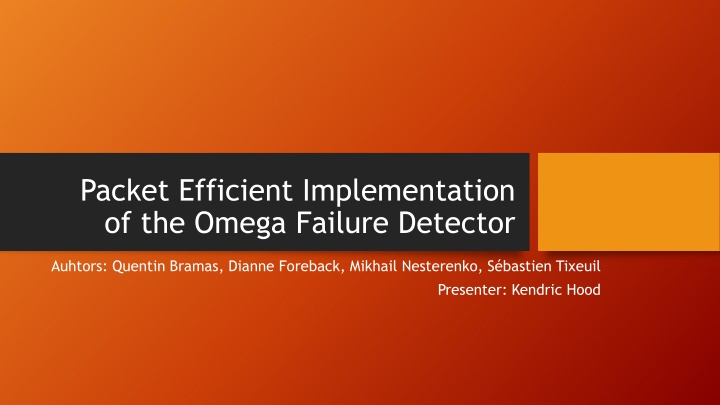
Efficient Implementation of Omega Failure Detector
Explore the concepts of failure detection in distributed systems, such as the Omega failure detector, limitations of achieving consensus with one fault, leader election strategies, and the importance of reliable channels in maintaining system integrity.
Download Presentation

Please find below an Image/Link to download the presentation.
The content on the website is provided AS IS for your information and personal use only. It may not be sold, licensed, or shared on other websites without obtaining consent from the author. If you encounter any issues during the download, it is possible that the publisher has removed the file from their server.
You are allowed to download the files provided on this website for personal or commercial use, subject to the condition that they are used lawfully. All files are the property of their respective owners.
The content on the website is provided AS IS for your information and personal use only. It may not be sold, licensed, or shared on other websites without obtaining consent from the author.
E N D
Presentation Transcript
Packet Efficient Implementation of the Omega Failure Detector Auhtors: Quentin Bramas, Dianne Foreback, Mikhail Nesterenko, S bastien Tixeuil Presenter: Kendric Hood
Impossibility of Consensus with One Fault Consensus can not be done in an asynchronous system and unbounded message delay. A node can not tell if another has crashed or is simply slow. Leading to waiting forever.
Enter Failure Detectors A failure detector allows nodes to find crashed nodes, takes place of an Oracle. Relies on timeouts and can make mistakes Must have two properties 1. Completeness: There some point where every crashed node is detected 2. Accuracy: There is a time where at least one node that is correct is not mistakenly marked crashed
Omega (failure detector in limited synchrony) Every Nodes has a variable that keeps track of a leader. This leader must have timely reliable links to all other nodes. Only one nodes must have these links They can be only outbound After some time every node must agree that this is the leader
Packet Efficient Implementation of the Omega Failure Detector What if the leader does not have a single hop to all nodes? This is very unlikely Use a path instead (from leader to all other nodes instead) Relies on broadcasts
Leader Election Leader candidate estimates reliability of channels by building arboresence Arboresence: is a directed graph where from a root there is one path to every other node Each node attempts to be the leader at the start, then collect messages from other nodes and calculates the arboresence for each one. The Node with the lowest weighted arboresence is leader
Leader change Leader then sends alive messages to all nodes along the arboresence. Sometimes these messages may be dropped (at some in between point) Nodes take turns broadcasting the leaders alive message This allows nodes that did not receive the message to send a failed message to the leader so that they may update there arboresence Then a node has a lower arboresence then the current leader then it becomes the leader
Fitting into Failure Detectors Eventually one leader must become the permanent leader This allows the algorithm to fit the definition of Failure Detectors
